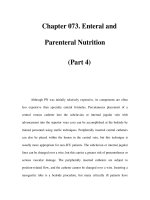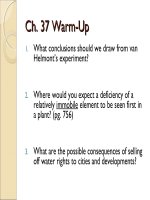Lecture Discovering nutrition - Chapter 4: Carbohydrates: simple sugars and complex chains spotlight on alcohol
Bạn đang xem bản rút gọn của tài liệu. Xem và tải ngay bản đầy đủ của tài liệu tại đây (2.05 MB, 41 trang )
Chapter 4
Carbohydrates
: Simple
Sugars and
Complex
Chains
What Are Carbohydrates?
•
•
Sugars, starches, and
fibers
Major food sources:
Plants
–
•
Produced during
photosynthesis
Two main carbohydrate
types
–
Simple (Sugars)
–
Complex (Starches and
Simple Sugars
•
Monosaccharides
–
Glucose
–
Fructose
–
Galactose
Simple Sugars
•
Disaccharides: Consist
of two
monosaccharides
linked together
–
Sucrose
–
Lactose
–
Maltose
Monosaccharides
•
Glucose
–
Most abundant simple sugar in nature
–
Also called dextrose
–
Gives food a mildly sweet flavor
–
Usually joined to another sugar in foods
–
Provides energy to body cells
•
Body closely regulates blood sugar levels
Monosaccharides
•
Fructose
–
Also called levulose or fruit sugar
–
Tastes the sweetest of all the sugars
–
Occurs naturally in fruits and vegetables
–
Found in fruits, honey, and corn syrup
Monosaccharides
•
Galactose
–
Rarely occurs as a monosaccharide in food
–
Usually bonds to glucose to form lactose
•
Primary sugar in milk and dairy products
Disaccharides
•
•
Sucrose: glucose + fructose
–
“Table sugar”
–
Made from sugar cane and sugar beets
–
Listed as sugar on food labels
Lactose: glucose + galactose
–
“Milk sugar”
–
Found in milk and milk products
Disaccharides
•
Maltose: glucose + glucose
–
“Malt sugar”
–
Seldom occurs naturally in foods
–
Product of starch breakdown
–
Found in germinating cereal grains
Complex Carbohydrates
•
Chains of two or more sugar molecules
–
Oligosaccharides
•
•
–
Three to ten sugar molecules
Examples sources: dried beans, peas,
and lentils
Polysaccharides
•
•
Long chains of monosaccharides
Structural differences affect how they
behave in water and with heating
Complex Carbohydrates
•
Starch
–
Plants store energy as starch
–
Found in grains, legumes, and tubers
(potatoes and yams)
–
Long chains of glucose units
–
•
Amylose—straight chains
•
Amylopectin—branched chains
Resistant starch: A starch that is not
digested
Complex Carbohydrates
•
Glycogen
–
Living animals store carbohydrate in the
form of glycogen
–
Provides body glucose when blood
glucose levels get low
–
Highly branched chains of glucose units
–
Most stored in our skeletal muscle and
liver
–
Carbohydrate “loading”
Complex Carbohydrates
•
Fiber
–
Nondigestible carbohydrates and lignins
–
Dietary fiber: Found in plants
•
Fruits, vegetables, legumes, and whole
grains
–
Functional fiber: Isolated and added to
foods
–
Total fiber: Sum of dietary fiber and
functional fiber
Complex Carbohydrates
•
Types of fiber
–
Cellulose
•
–
Hemicelluloses
•
–
Indigestible by humans and a
component of dietary fiber
Variety of monosaccharides with many
branching side chains
Pectins
•
Dietary fiber found in all plants,
especially fruits
Complex Carbohydrates
•
Types of fiber
–
Gums and cilages
•
–
Gel-forming fibers that help hold plant
cells together
Lignins
•
Indigestible substances that make up
woody parts of vegetables and the
seeds of fruits
Complex Carbohydrates
•
Types of fiber
–
Beta-glucans
•
–
Polysaccharides of branched glucose
units
•
Found in barley and oats
•
Help decrease blood cholesterol levels
Chitin and chitosan
•
Primarily consumed in supplement form
•
Marketed as weight-loss supplements
Carbohydrate Digestion and
Absorption
•
Digestion breaks down carbohydrates to
single sugars
–
Mouth
•
–
Salivary amylase begins digestion of
carbohydrates
Stomach
•
Acidity of stomach juices halt action of salivary
amylase and stops carbohydrate digestion
Carbohydrate Digestion and
Absorption
•
Digestion
–
Small intestine
•
Pancreatic amylase continues starch
digestion
•
Brush border enzymes digest disaccharides
•
Other digestive enzymes
–
Maltase, sucrase, and lactase split
maltose, sucrose, and lactose,
respectively
Carbohydrate Digestion and
Absorption
•
Digestion
–
Bonds that link glucose molecules
•
Alpha bonds
–
Broken down by human enzymes
»
•
Starch
Beta bonds
–
Bonds remain unbroken by human
enzymes
»
Cellulose
Carbohydrate Digestion and
Absorption
•
Digestion
•
Enzymes
–
Highly specific
»
•
Examples include lactase and Beano
Some carbohydrates remain intact, such
as fiber and resistant starch
Carbohydrate Digestion and
Absorption
•
Absorption: The small intestine swings into
action
–
–
End products of carbohydrate digestion
•
Glucose
•
Galactose glucose
•
Fructose glucose
Liver
•
Stores and releases glucose as need to maintain
blood glucose levels









